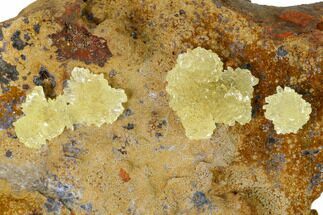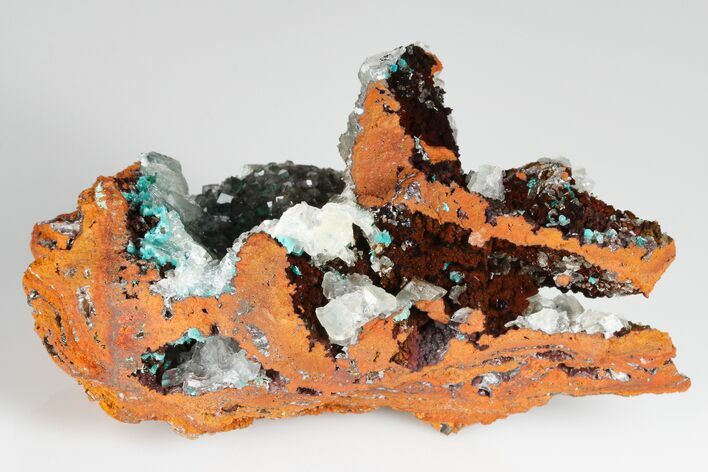This Specimen has been sold.
3.8" Rosasite and Calcite Crystal Association - Mexico
This colorful specimen features aggregations of rosasite and calcite crystals that formed from a limonitic matrix. This beautiful specimen was collected from the Ojuela Mine in Durango, Mexico.
Rosasite is a secondary mineral that forms in oxidation zones of copper-zinc deposits, generally forming a fibrous botryoidal sphere that can appear vitreous and silky. While typically featuring a blue-green color, colorless specimens are not unheard of. The chemical formula of rosasite is CuZnCO3(OH)2.
About Calcite Crystals
Calcite crystals are a form of calcium carbonate (CaCO₃) known for their diverse shapes, transparency, and vibrant range of colors. They typically form in rhombohedral, scalenohedral, or prismatic shapes, often with well-defined, sharp edges and glossy surfaces. Calcite crystals are often translucent or transparent, sometimes displaying a double refraction effect where objects viewed through the crystal appear doubled. They can appear in various colors—white, clear, yellow, pink, blue, green, and orange—depending on impurities or trace minerals.
A notable characteristic of calcite is its reaction with weak acids like vinegar, which causes it to effervesce, or fizz, as it releases carbon dioxide. This property makes calcite crystals a key tool in geological identification and studies. Calcite forms in many environments, from sedimentary rocks like limestone and marble to hydrothermal veins.
Calcite crystals are a form of calcium carbonate (CaCO₃) known for their diverse shapes, transparency, and vibrant range of colors. They typically form in rhombohedral, scalenohedral, or prismatic shapes, often with well-defined, sharp edges and glossy surfaces. Calcite crystals are often translucent or transparent, sometimes displaying a double refraction effect where objects viewed through the crystal appear doubled. They can appear in various colors—white, clear, yellow, pink, blue, green, and orange—depending on impurities or trace minerals.
A notable characteristic of calcite is its reaction with weak acids like vinegar, which causes it to effervesce, or fizz, as it releases carbon dioxide. This property makes calcite crystals a key tool in geological identification and studies. Calcite forms in many environments, from sedimentary rocks like limestone and marble to hydrothermal veins.
SPECIES
Rosasite & Calcite
LOCATION
Ojuela Mine, Mapimi, Durango, Mexico.
SIZE
3.8 x 1.7"
CATEGORY
ITEM
#180774
 Reviews
Reviews














